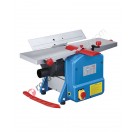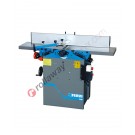You have no items in your shopping cart.
Rollawaycontainer.com srl
Via Luigi Cadorna, 56 - 58
30020 Fossalta di Piave - Venezia (Italia)
Tel. +39 421 67358
Fax +39 421 306462
[email protected]
This website uses cookies to improve users' browsing experience and to gather information on their use of the website. We also use third-party profiling cookies to send advertising messages in line with user preferences. You can learn more and manage your choice at any time by visiting our cookies policy.

Planers are woodworking machines that are used to make a rough surface flat and smooth, or to reduce the thickness of a board, giving it a predetermined thickness. Surface planers allow you to perform surface planing, that is the process that allows you to obtain a smooth surface on a piece of wood. Thicknessers, on the other hand, are used to give a wooden plank a certain thickness. The thicknessing planers are therefore a combined machine that allows you to perform both processes with a single tool.
During the flush planing operations, the piece of wood is slid over the planer shaft and the lower surface is planed. The thickness that is removed can be adjusted by acting on the height of the table. During thickness planing, on the other hand, the piece of wood rests on the height-adjustable platform of the instrument, and advances under the planer shaft. In this way the upper surface of the wooden plank is processed.
The available models of thicknessers planers, as well as those that only allow the planing of the thickness or edge, must be connected to a dust extraction system before each process. Furthermore, all machines are equipped with protection systems. In fact, there are protective casings that have the task of preventing the operator from coming into direct contact with the transmission parts of the machine when it is in action.
Important features that must be taken into consideration when choosing thicknessers planers are certainly the size and height of the tops. In fact, these are characteristics that affect the machining that can be carried out and the pieces that can be machined. Also for thickness planers the dimensions of the worktops are important characteristics to be evaluated.
From €569.40 (ex. VAT)
From €402.00 (ex. VAT)
From €1,307.01 (ex. VAT)
From €1,854.21 (ex. VAT)

Plastic bins
Security and environment
Bins
Bunded pallets in polyethylene or steel
Drum dispensing and supports
Outside storage containers and cabients in steel and polyethylene
Metal sheds, portacabins and shipping containers, portable toilets
Metal shelving for the storage of drums, IBC and containers
Gas bottle storage depots and cabinets
Safety barriers and jersey barriers

Shop fittings and workshop storage

Trucks and warehouse trolleys

Metal containers
Steel containers and laundry trolleys
Wire containers
Dumping bins and tipping skips
Sheet metal industrial containers
Mesh industrial containers
Drop bottom skips and bins
Open fronted metal containers
Metal storage boxes and bins
Crane boat skips and concrete buckets for building
Site boxes for tools

Insulated containers

Packaging and shipping supplies

Pallets

Wheels and castors

Lifting equipment and loading

Machine tools and processing machinery

Power tools and hand tools
Tool sets and assortments
Tool kits in cases and boxes
Wrenches and spanners
Screwdrivers
Male-end wrenches
Bits and bit holders
Sockets and accessories
Torque wrenches and multipliers
Pliers, wire cutters and nippers
Drills, impact drivers and pneumatic tools
Punches, drift, pin and centre punches
Car jacks, car and motorcycle lifters
Car battery chargers and starters
Cable reels and hose reels
Shopping Options


































Rollawaycontainer.com srl
Via Luigi Cadorna, 56 - 58
30020 Fossalta di Piave - Venezia (Italia)
Tel. +39 421 67358
Fax +39 421 306462
[email protected]
Copyright © 2014 - Rollawaycontainer.com srl - CF/N.Iscr.Reg Imp VE/PI 03394420271 - REA n° 304615
Cap. Soc. 20.000 € i.v. - E-mail: [email protected]




